I met with an author client recently to talk about the next step in his book-writing process. He’d recently completed the first draft of his manuscript and, I could be wrong here, I’m pretty sure he was hoping to hand the whole darn thing over to me and be done with it.
“Now it’s time to start revising,” I said (brightly).
He looked a bit haunted, so I walked him through the Carolyn See method of revision. Do you know about Carolyn See? She’s a book reviewer, professor, novelist, and the author of my favorite book on writing, Making a Literary Life: Advice for Writers and Other Dreamers. Her revision strategy is wonderfully simple and straight-forward. It’s comprised of four parts, but we’re just going to tackle the first two here for now. Baby steps.
Step One: Non-Judgemental Read-Through
If you haven’t already done so, print out a copy of your manuscript. Take a moment to enjoy the physical weight of all your hard work. It feels good, doesn’t it?
Right now, your job is simply to read through the manuscript. Try as hard as you can to read the entire draft without judgement. If something really bugs you, say, a paragraph that makes absolutely no sense, you can write fix? in the margin and then keep reading.
I’m about to sit down and read through the first draft of my children’s book, pink felt-tipped pen in hand. Even if I can’t control myself and start writing what were you thinking? on every page, I’m sure it won’t feel nearly as critical in pink as it would in red.
Step Two: Making a Map
Congratulations on surviving your first read-through! It’s possible that you’re locked in your bedroom with a pint of Häagen-Dazs, wondering why any sane person would put herself through this. Well, shake it off because it’s time for Step Two: Making a Map.
For the second read-through, things are going to get a bit more serious. Get some blank computer paper and divide the blank paper vertically, draw another line across the top, and label it:
Ch. One
What I Have (first column) | What I Need (second column)
Then read through your manuscript again and jot down some notes as you go. Ms. See describes this process as making a map of your story so you’ll have a very clear idea about what’s happening and what’s missing.
So your map might look like this:
Ch. One
What I Have (first column) | What I Need (second column)
p. 1
Introduce Meg | What does she want?
p. 2
Meet her family | way too many people showing up at once
p. 3
grandparents’ store | add description of store and town
After you’ve read through the entire manuscript and made as many notes as you can, you’re going to read it a third time with your map in hand so you can start making the changes you need to make. You can cross off items in the right-hand column as you go.
Depending on how long your manuscript is, these first two steps might take some time to complete. My goal is to do the Non-Judgemental Read-Through this weekend and then start in on Making a Map on Monday.

